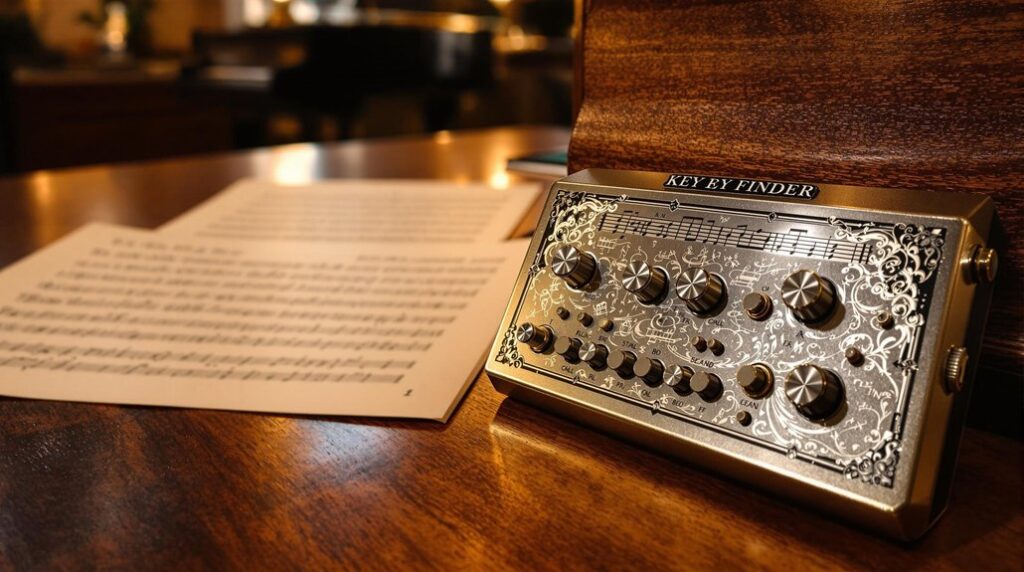Determining a song's key involves analyzing the final chord and charting the song's chords for resolution points. Familiarity with key signatures, using concepts like the Circle of Fifths, clarifies sharps and flats. Employ ear training techniques to enhance pitch recognition, or utilize key detection software for quick results. Recognizing chord progressions and identifying the tonic note further aid in establishing the key. Exploring these concepts will deepen one's understanding of musical key identification.
Key Takeaways
- Use key detection software for immediate and accurate key identification.
- Analyze the final chord to reveal the tonic chord and confirm the key.
- Chart the song's chords to identify common progressions indicating the key.
- Familiarize yourself with the Circle of Fifths for quick key signature recognition.
- Practice ear training to enhance pitch recognition and tonal center awareness.
Analyze the Final Chord
Analyzing the final chord of a musical composition is a fundamental technique for determining its key. Typically, the final chord reveals the tonic chord, which confirms the key by providing closure. For instance, ending on a C major chord suggests the composition is in the key of C major. This conclusion is often reinforced by a preceding dominant chord, which resolves to the tonic, establishing a clear tonal center. However, if the final chord is ambiguous, analyzing the chord progression becomes necessary. Identifying the relationships among chords can elucidate the key, even if the ending chord does not directly indicate it. Consequently, the final chord plays an essential role in determining the key, especially when supported by the dominant and tonic chords. Additionally, a mastery of chord progressions allows DJs to predict changes in energy and manipulate tracks effectively, enhancing the overall impact of a musical set.
Chart the Song's Chords
After examining the final chord, attention shifts to charting the song's chords to further ascertain its key. This process involves systematically listing all the chords to visualize their relationships and functions within musical keys.
The following steps are pivotal:
- Identify the Tonic Chord: This chord acts as the resolution point, aiding in determining the key. Recognizing the tonic chord often provides immediate insight into the major key.
- Utilize Reference Materials: Tools like a Guitar Key Guide can match charted chords with potential key signatures, narrowing down possibilities.
- Observe Common Chord Progressions: Progressions such as I-IV-V frequently indicate a major key, guiding the analysis.
- Listen and Confirm: By listening to the song while analyzing, one can verify the tonal center, solidifying the understanding of the key.
Incorporating harmonic mixing techniques can further refine the determination of a song's key, ensuring that transitions between tracks are smooth and cohesive.
Familiarize With Key Signatures
Key signatures serve as vital visual symbols in music notation, denoting the specific sharps or flats that define the tonal center of a composition.
Each major key is characterized by a distinct pattern of sharps or flats, with minor keys sharing these signatures with their relative majors.
Understanding the order of sharps and flats within a key signature is essential for accurately identifying the key of a piece, as it provides insight into the hierarchical structure of pitches within the musical scale.
Visual Symbols in Music
In musical notation, key signatures are essential visual symbols found at the beginning of a staff, denoting the specific collection of sharps or flats that define the key of a composition.
These key signatures assist musicians in identifying the key and determining a song's key efficiently. Understanding this concept involves several technical aspects:
- Key signatures correlate to 12 major keys, each with unique sharps or flats.
- Minor keys share key signatures with their relative major keys, maintaining 12 key signatures overall.
- The Circle of Fifths aids in memorizing the order of sharps (F, C, G, D, A, E, B) and flats (B, E, A, D, G, C, F).
- The key of C major, devoid of sharps or flats, serves as a reference for other keys.
Major and Minor Keys
Having explored visual symbols in music through key signatures, attention now shifts to understanding the complex relationship between major and minor keys.
Key signatures serve as critical indicators of a song key by denoting specific sharps and flats that define each major scale and its corresponding relative minor. Each of the 12 major keys is associated with a unique combination of sharps or flats, while every minor key shares its signature with a major key. This duality highlights the interconnectedness within music theory.
Major keys typically resonate with a brighter tonality, contrasting the darker sonority of minor keys. Grasping the concept of key signatures not only aids in sight-reading but also enhances one's ability to quickly identify and interpret the emotional quality of musical compositions.
Sharps and Flats Order
Understanding the order of sharps and flats is essential for mastering key signatures in music theory. This knowledge enables musicians to accurately identify the key of a piece.
Musicians should note the following:
- Order of Sharps: F, C, G, D, A, E, B. The last sharp is the leading tone; the tonic is a half-step higher.
- Order of Flats: B, E, A, D, G, C, F. The second flat from the right determines the key center.
- Major Keys: Each of the 12 major keys has a distinct combination of sharps or flats.
- Minor Keys: These share their key signatures with relative major keys, simplifying identification.
Practice Ear Training
Ear training serves as an important component in the development of a musician's ability to identify musical keys, focusing on pitch recognition and tonal center awareness. It enhances key detection by allowing musicians to discern major and minor scales and confirm the key through listening to the song. Regular practice in identifying chords used within the key of the song sharpens this skill. Apps or software offering ear training exercises can be significant tools. They enhance interval recognition, essential for distinguishing between major and minor keys. Additionally, transcribing melodies by ear helps in understanding note relationships to their key signatures. Understanding modal interchange can diversify progressions and add depth to the practice of ear training.
| Exercise Type | Benefit |
|---|---|
| Interval Recognition | Distinguish major/minor keys |
| Chord Identification | Confirm key of the song |
| Melody Transcription | Understand key signatures |
| Active Listening | Enhance musical intuition |
| Software/App Use | Structured practice |
Utilize Key Detection Software
While practice in ear training sharpens a musician's ability to identify musical keys through auditory skills, key detection software offers a more immediate and technological solution. Tools like DJ.Studio utilize AI to determine the Key of A Song instantly, streamlining the workflow for musicians. Here are key features:
- Instant Identification: Users can quickly identify whether music is centered in a major or minor key, affecting whether it will sound happy or somber.
- Harmonic Compatibility: Some software guarantees tracks maintain key compatibility, critical for seamless shifts.
- Ease of Use: Importing songs for analysis negates the need for extensive training, democratizing access to key detection.
- Availability: Both free and paid options accommodate varying skill levels, enhancing performance capabilities.
Additionally, advanced key detection is a feature in some top DJ software like Engine DJ and Rekordbox, which helps in harmonically matched mixes for seamless transitions. This technology simplifies creating harmonically compatible playlists.
Examine Chord Progressions
Analyzing chord progressions provides a fundamental approach to determining the key of a song. By examining the chords in a song, one can identify whether it aligns with a particular major or minor key.
Diatonic chords, which derive from a specific key, play an important role in this analysis. For instance, a song using chord progressions like I-IV-V, typically found in the key of C major, can indicate its key. Conversely, progressions such as ii-V-I might suggest a minor key context.
Mapping these chords against a chart of possible keys helps clarify which key a song belongs to. Identifying common chord progressions and their relationships with particular keys is essential for accurate key determination.
Identify the Tonic Note
After examining chord progressions to deduce a song's key, identifying the tonic note becomes the next logical step. The tonic note serves as the first note of a scale, establishing the primary tonal center with a sense of resolution. To precisely identify it:
- Home Chord: Listen for the chord that feels like the "home chord," where the song frequently begins or ends.
- Scale Exploration: Play through the scale associated with the key and note which note feels most resolved.
- Root of I Chord: Recognize that the tonic note often corresponds to the root of the I chord within the key and chords structure.
- Ear Training: Enhance recognition through ear training exercises, which distinguish the tonic note from other scale notes.
Additionally, understanding chord progressions aids in creating emotional and dynamic shifts, further refining your ability to determine the tonic note. This methodical approach guarantees accurate identification.
Employ the Circle of Fifths
Understanding the Circle of Fifths is essential for musicians seeking to comprehend the intricate relationships between musical keys and their signatures. This tool visually represents how keys tend to sound, elucidating the number of sharps or flats in each.
For instance, C major, with no sharps or flats, is central to this circle. Moving clockwise, each step adds one sharp; moving counterclockwise adds one flat. To determine the relative minor key, one can locate the major key and shift three positions counterclockwise.
This method aids in identifying key signatures and understanding common chord progressions within music. Familiarity with the Circle of Fifths also enhances a musician's ability to transpose songs by visualizing the proximity between keys on the circle.
Frequently Asked Questions
What Is the Easiest Way to Figure Out the Key Signature of a Song?
To determine a song's key signature, one examines key signature basics, circle fifths explanation, and major/minor scales overview. Understanding accidentals' impact, transposing songs, and applying ear training tips also provide insights into identifying the correct key.
How to Identify What Key a Song Is In?
To identify a song's key, one should engage in music theory, focusing on chord progression, ear training, scale recognition, interval identification, and harmonic analysis. Incorporating these techniques offers practical songwriting tips for accurate determination.
What Is the Easiest Way to Identify a Piano Key?
To identify a piano key, one should utilize piano key techniques, focusing on visual key indicators and scale recognition methods. Ear training exercises, chord progression patterns, interval identification skills, and note identification strategies enhance accuracy in determining key signatures.
Is There an App That Finds the Key of a Song?
Yes, numerous music identification apps use key detection technology to identify a song's key. These song analysis software and audio recognition tools, including mobile music apps and key signature finders, integrate advanced music theory apps for precise results.
Conclusion
To sum up, determining a song's key can be achieved through various analytical methods. By analyzing the final chord and charting the song's chords, one gains insights into its tonal center. Familiarity with key signatures and practicing ear training enhances this understanding. Additionally, utilizing key detection software offers a technological advantage. Examining chord progressions and identifying the tonic note further solidify the analysis. Employing the Circle of Fifths provides an all-encompassing framework, ensuring accurate key identification.




